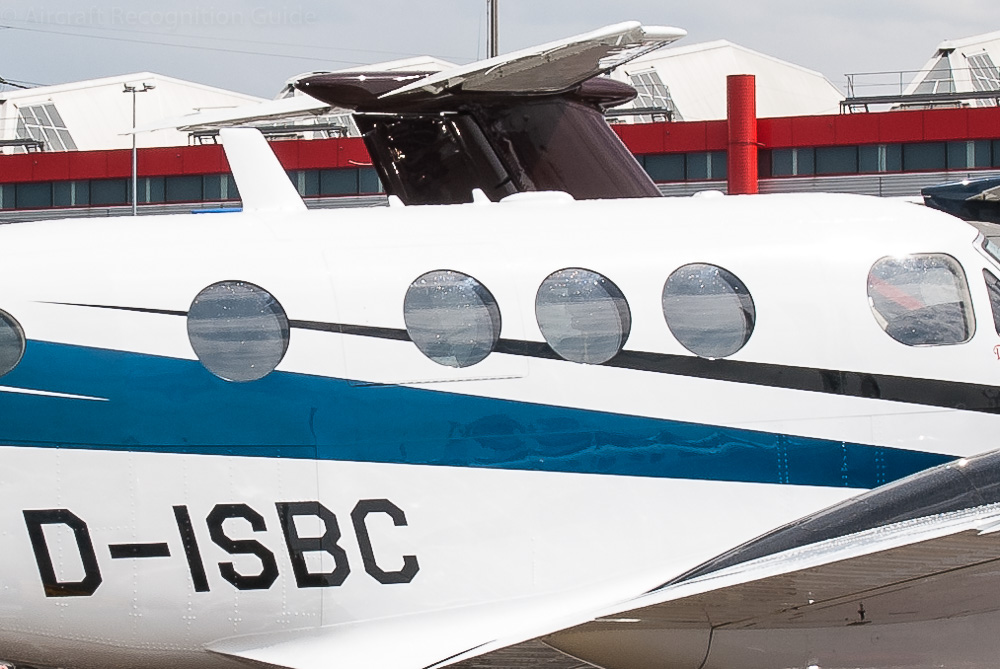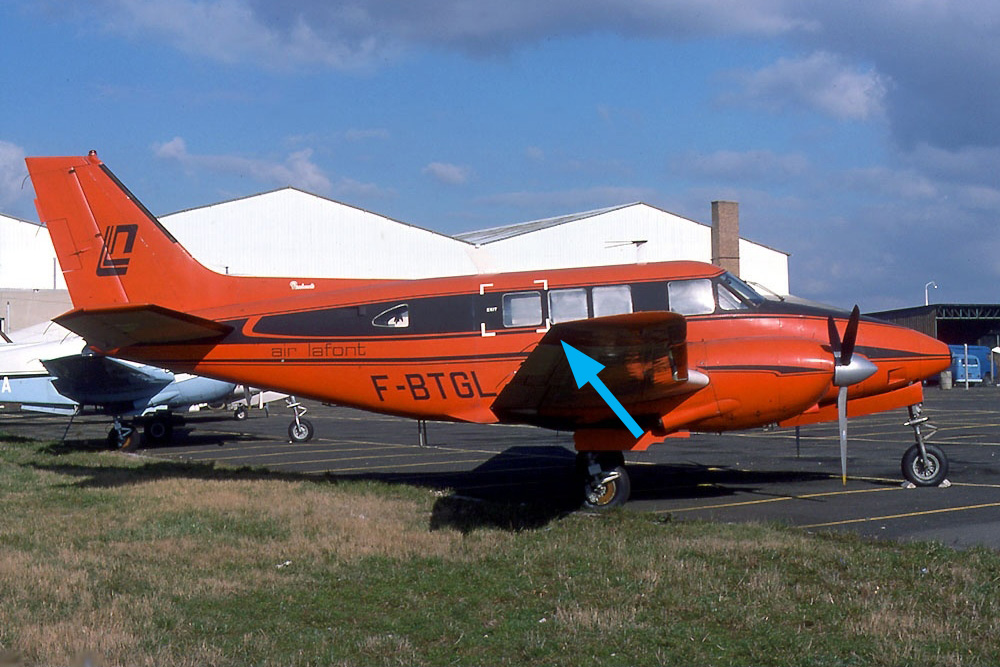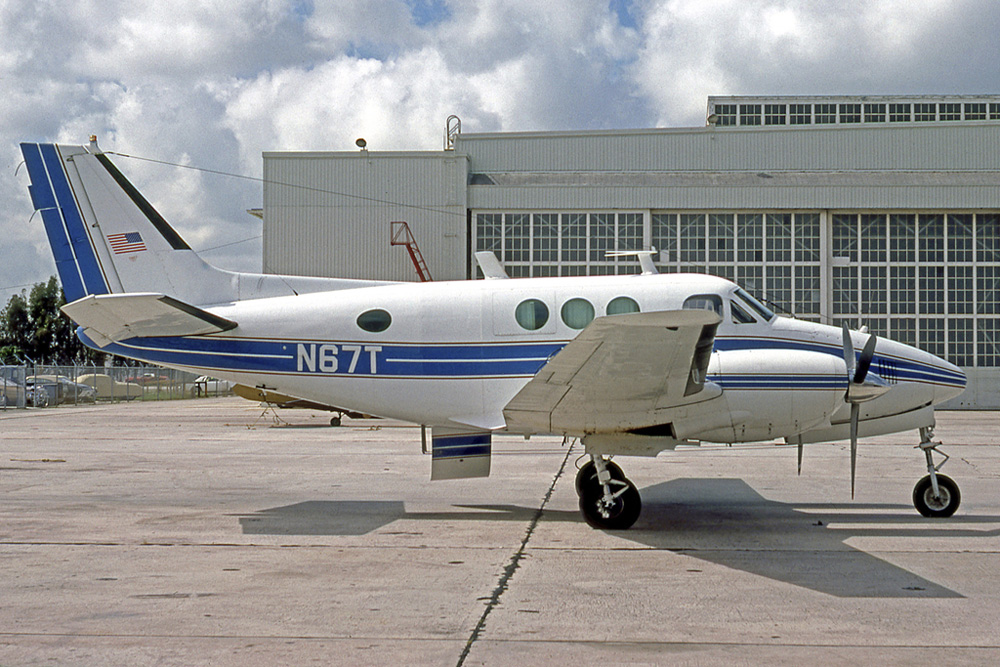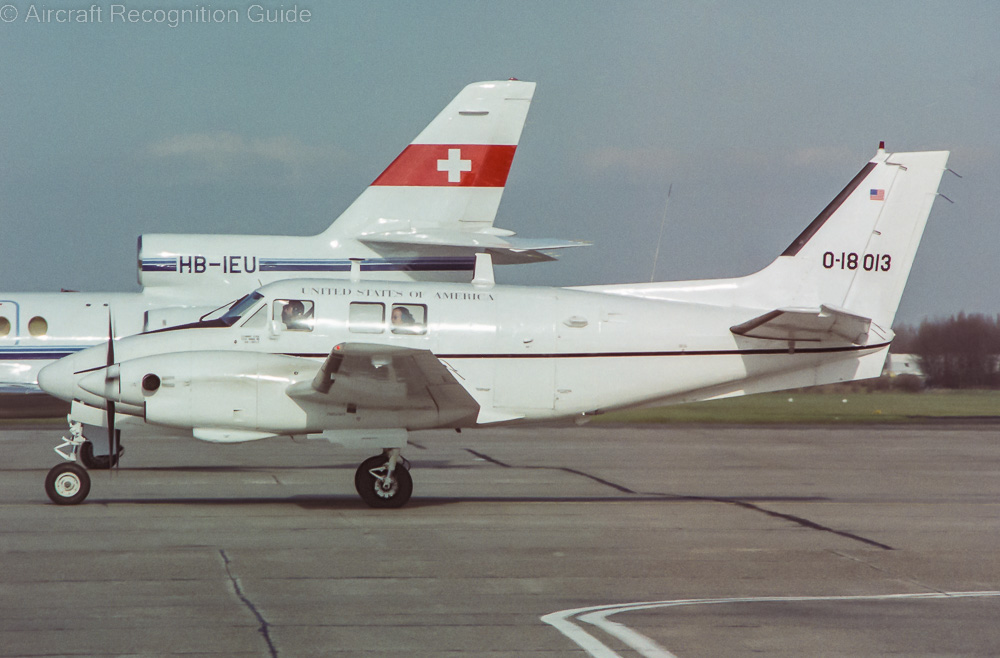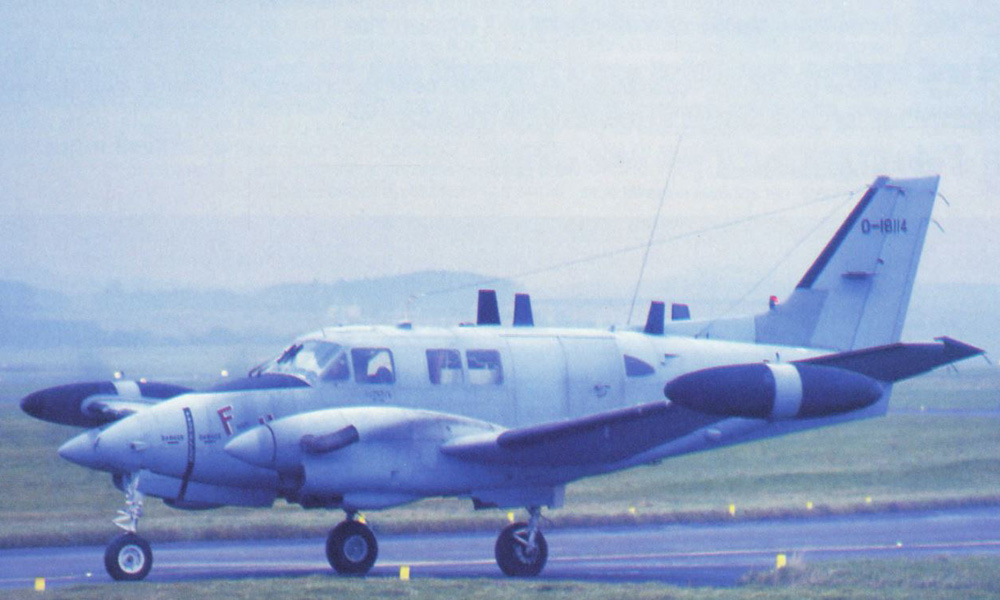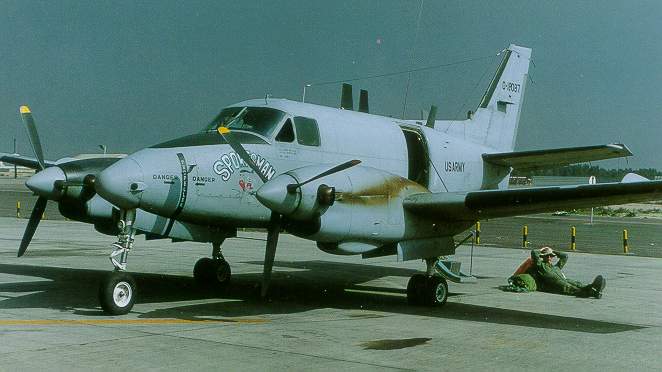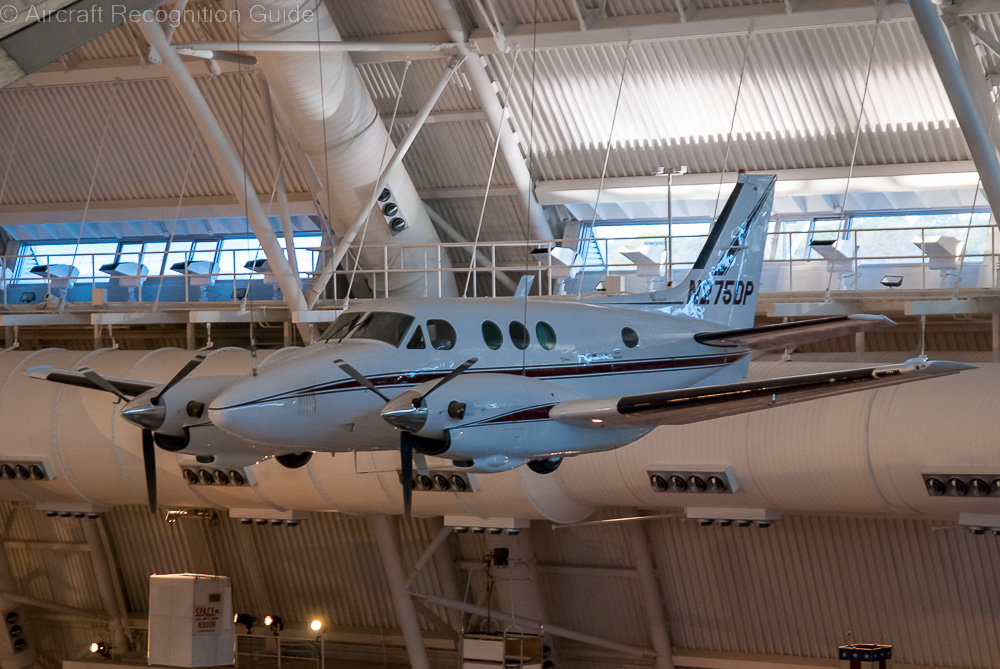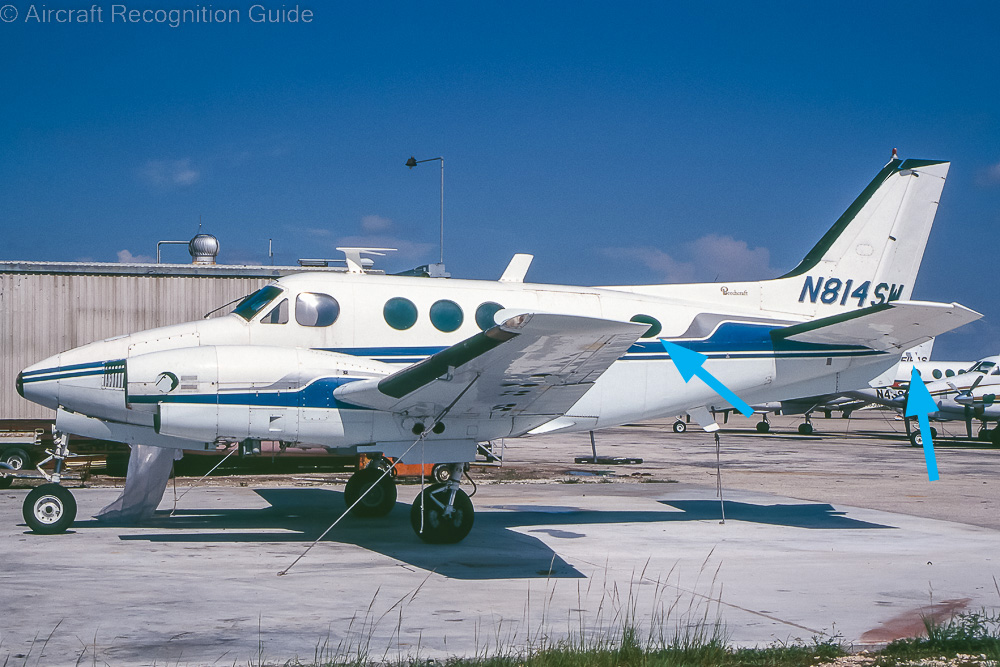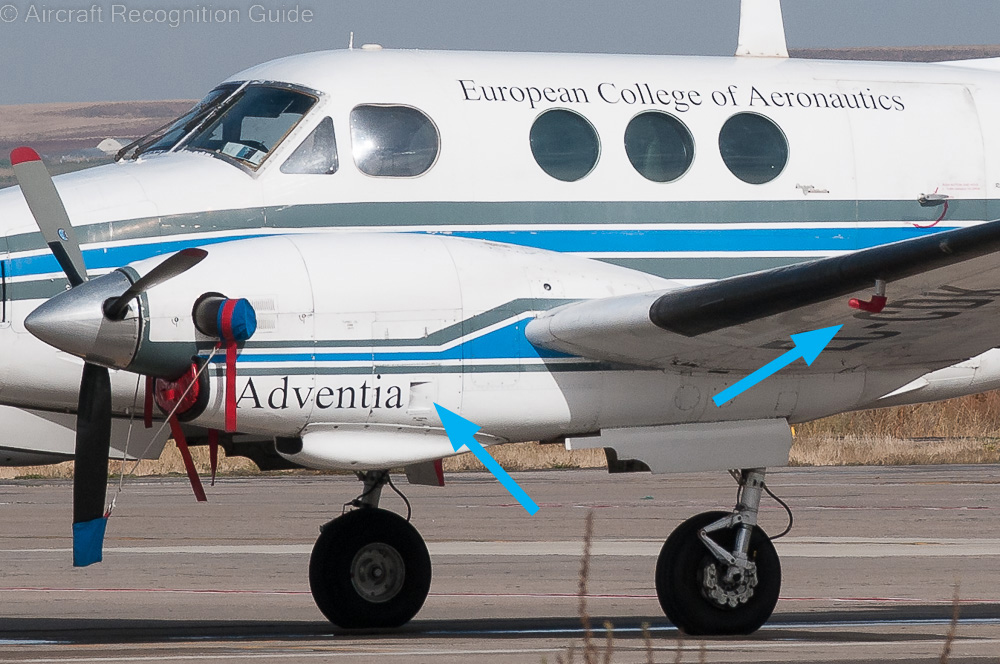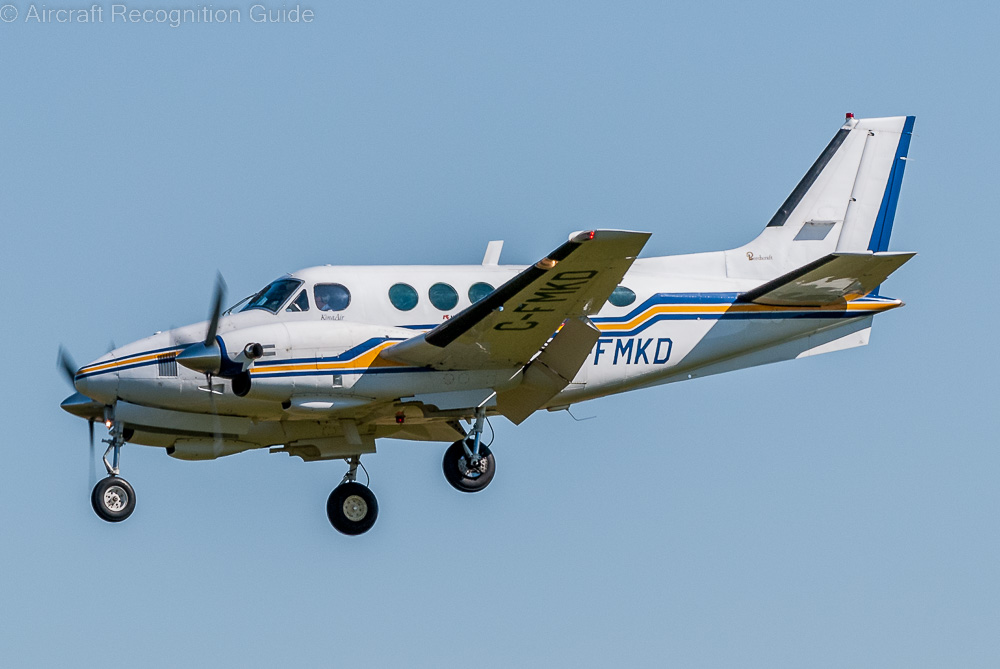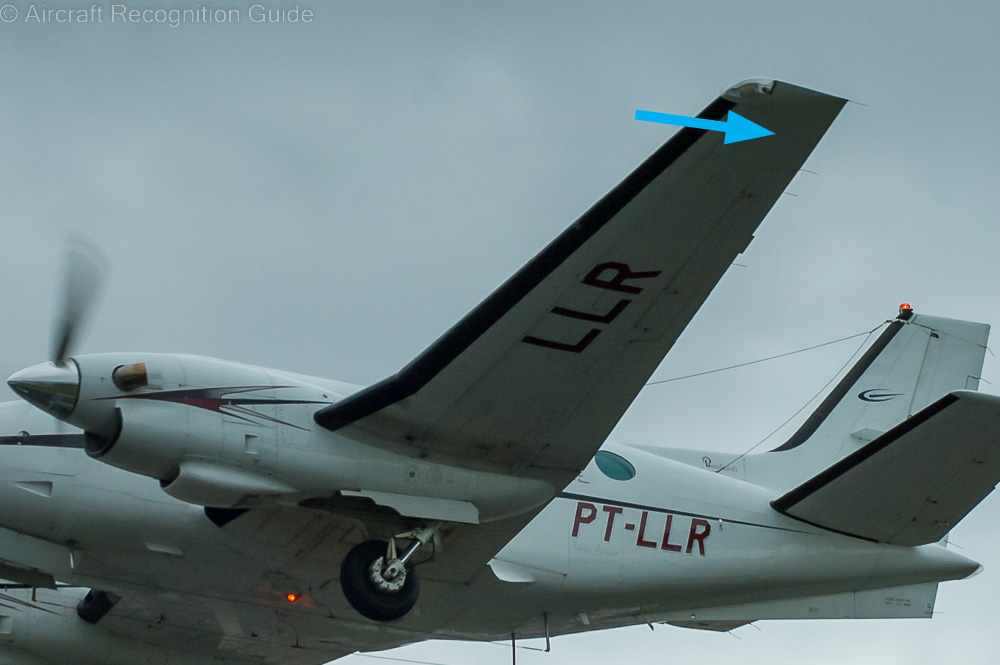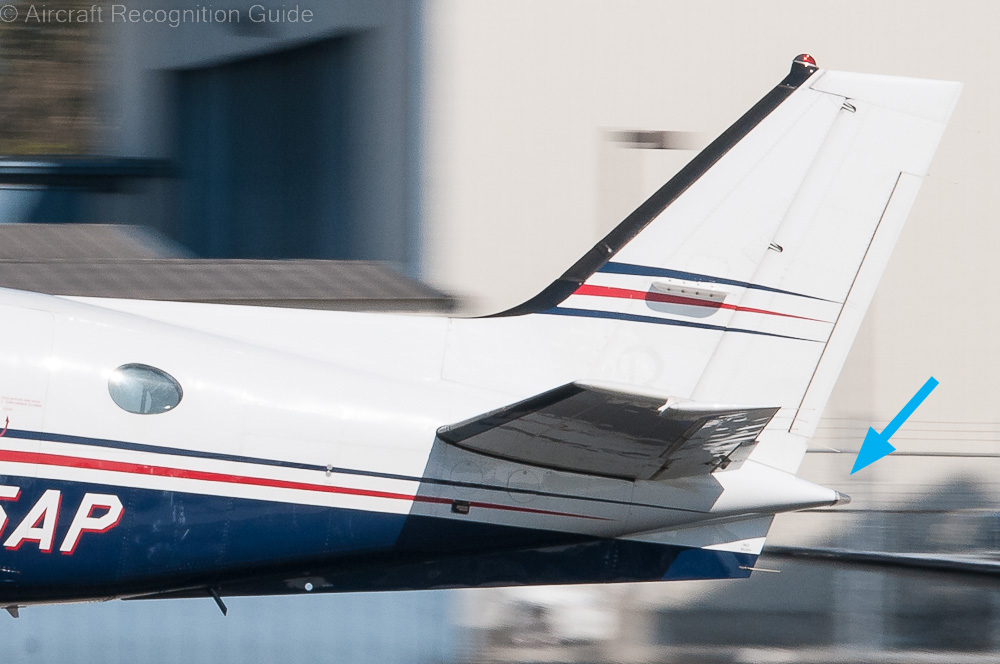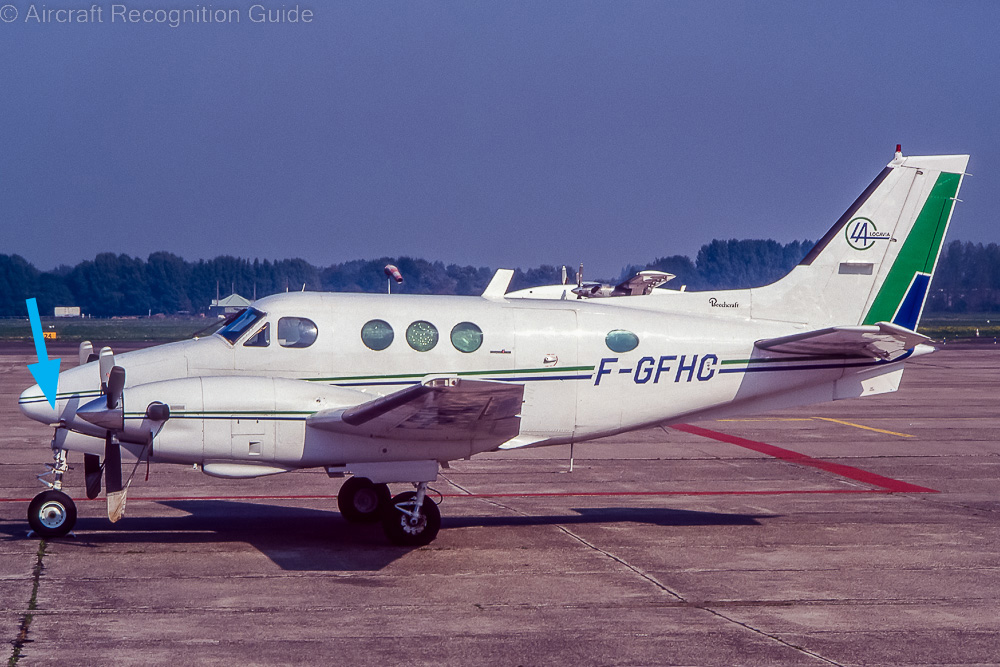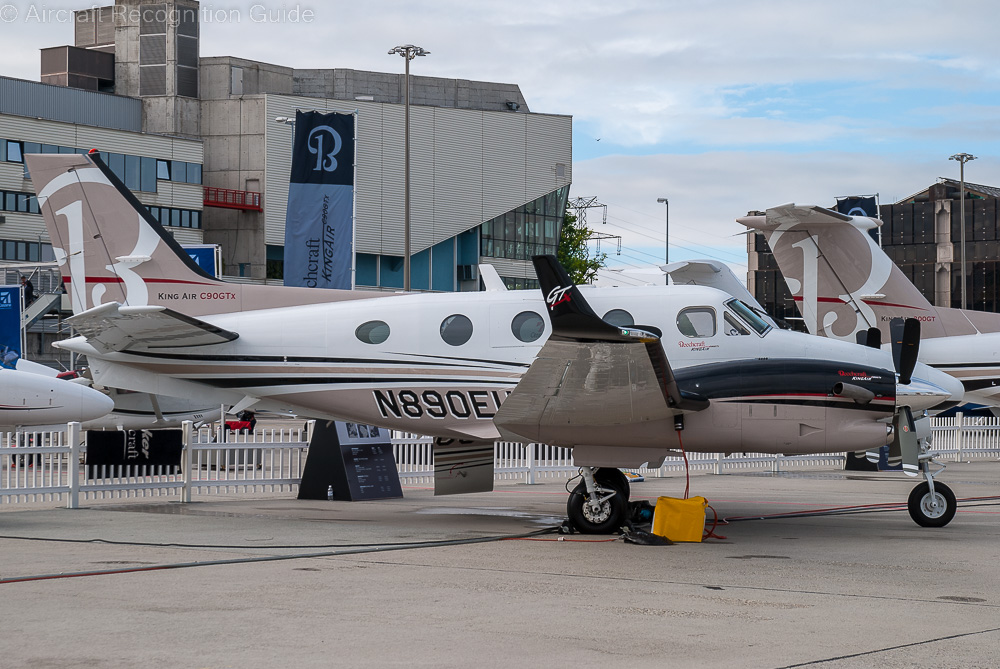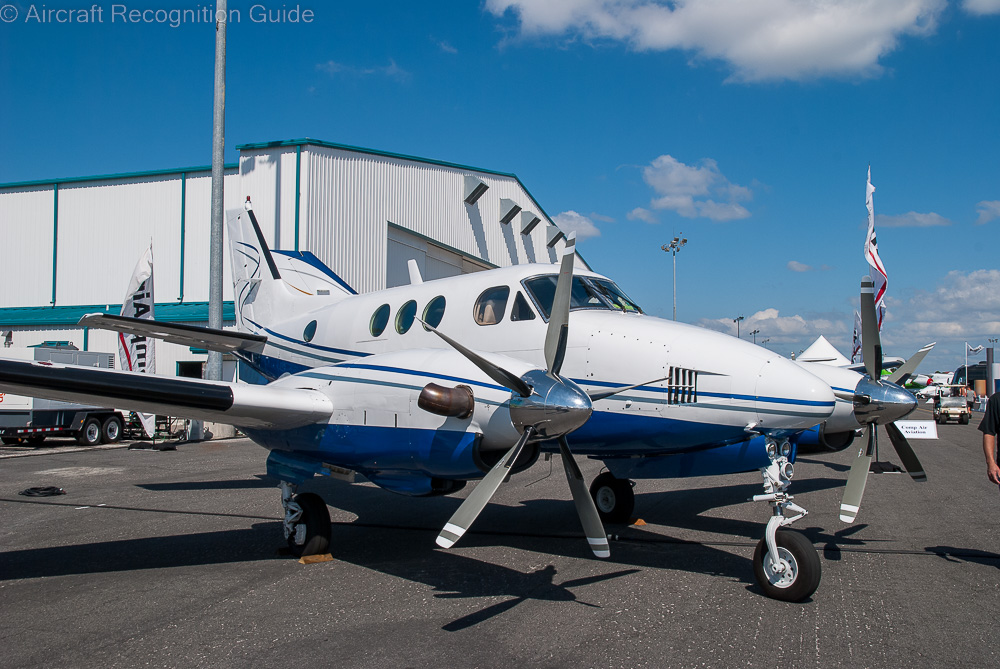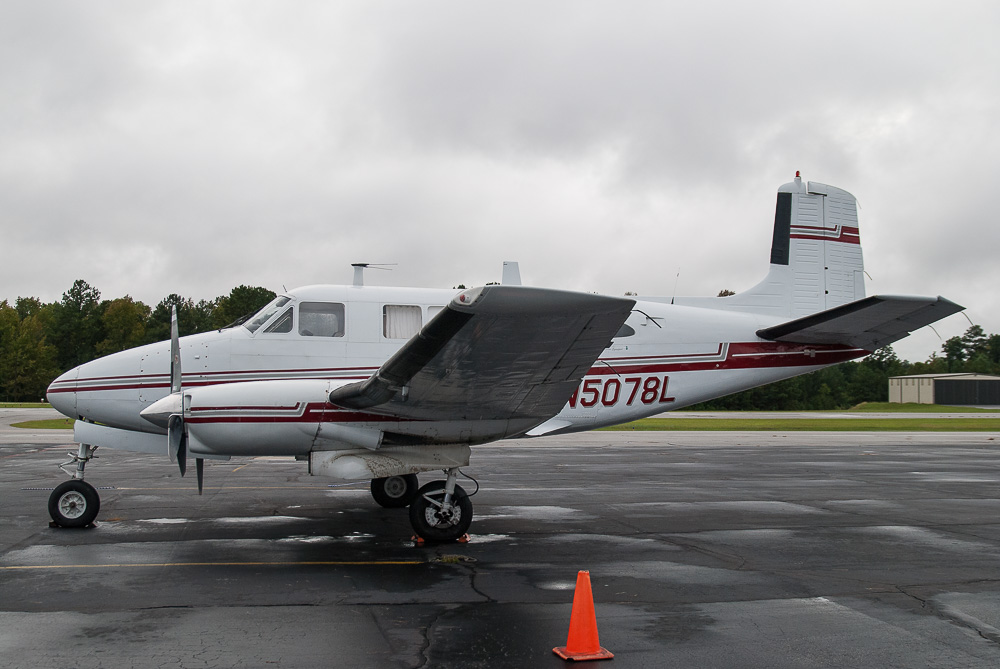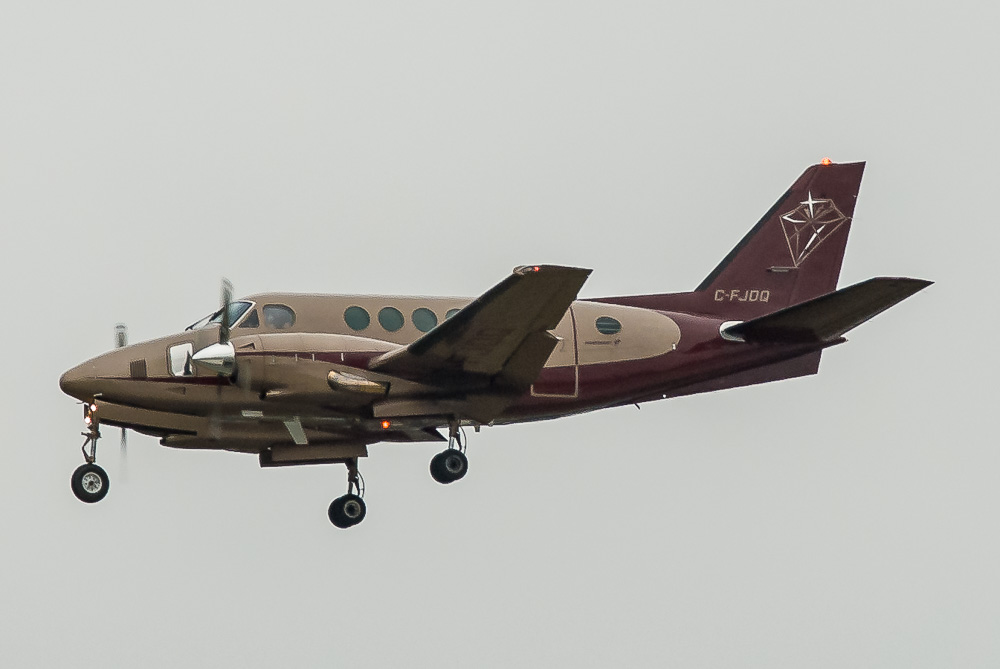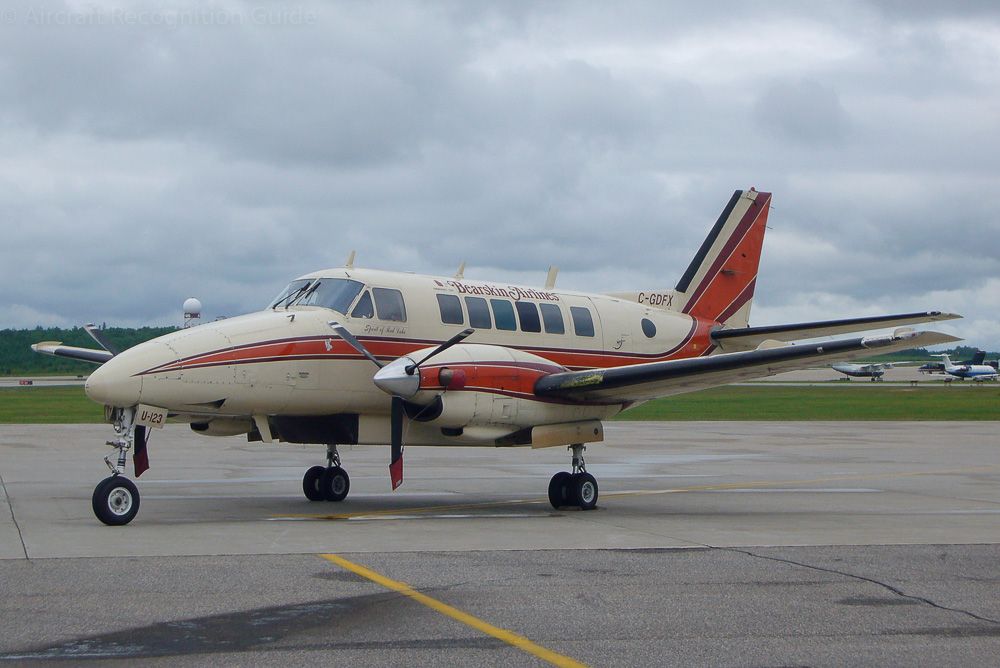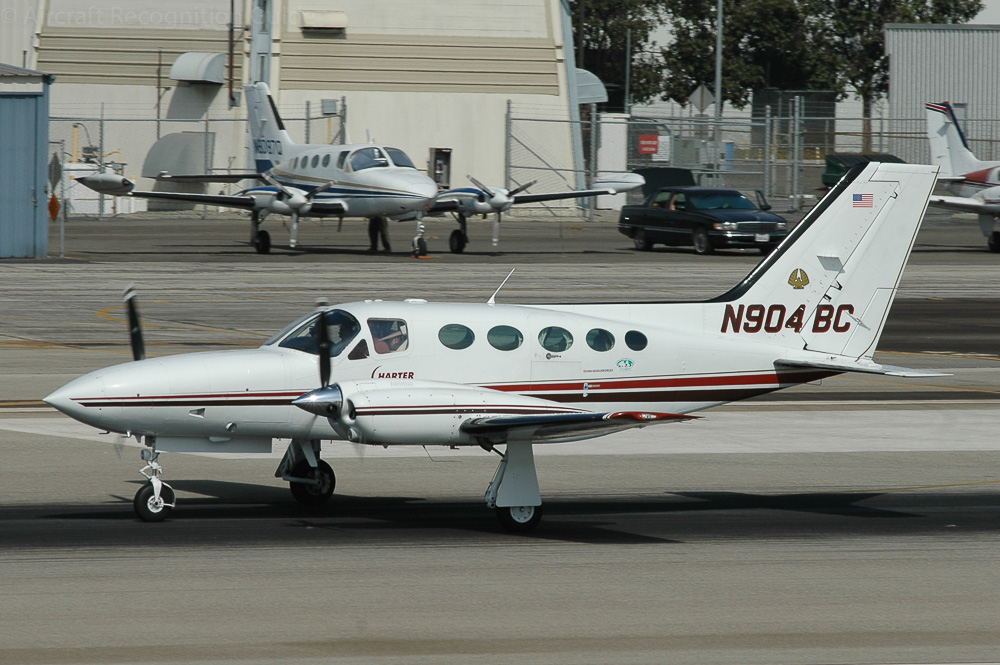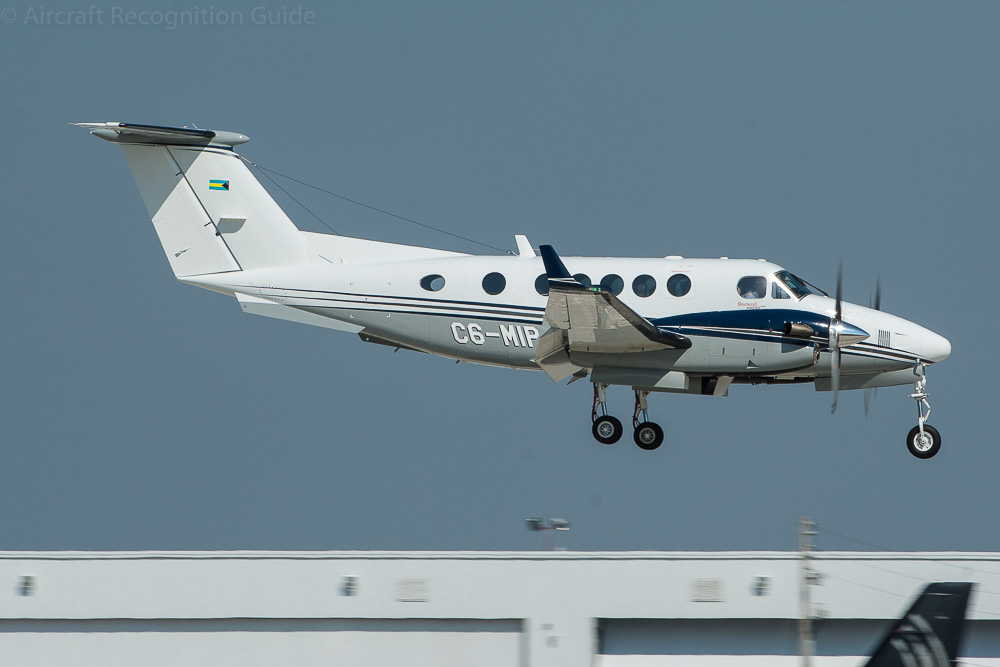
Beechcraft Queen Air & low tail King Air series
The Queen Air was the first type of Beechcraft’s very successful twin prop series, that later developed in the King Air. It is a low wing, low horizontal stabiliser aircraft, with two piston or turboprop engines and a main landing gear that retracts forward into the nacelles. The single wheel nose gear retracts rearward. While at first rectangular, almost square cabin windows were used, most versions have the round cabin windows that are still used on the King Airs that roll off the production line today. The same applies to the characteristic cockpit windows, with the typical triangular and D-shaped side windows.
Later also King Air versions with a T-tail started to be made, but these are described separately.
Different versions
The different versions of the Beech Queen Air and low tail King Air can be distinguished by:
- the shape of the vertical stabiliser
- the shape of the last cockpit side window
- the shape of the engine nacelles
- the number of propeller blades
- the location of the pitot tubes
- the size of the wing tips
- the presence of pods at the wing tips
- the number and shape of cabin windows
- the number, shape and location of antennas
- the shape of the tail cone
Beech 65 Queen Air / L-23F/U-8F Seminole
The Beech 65 Queen Air was developed from the Beech 50 Twin Bonanza, with a larger cabin featuring three square cabin windows. It does not have a D-shaped cockpit side window yet, but a rectangular one. The original Beech 65 has a straight vertical tail with small, curved dorsal fin. The Queen Air has piston engines in rather thick nacelles, which have a half ring (oval) shaped cooler intake at the front.
The US Army designation was L-23F Seminole, and U-8F after 1962.
Beech A65 Queen Air, Beech 80 (Beech 65-80) Queen Air, Queen Airliner & Beech A65-8200 Excalibur 8200
The Beech 80 was first introduced after the Beech 65, and is basically a 65 with a swept vertical tail and more powerfull engines. The Beech A65 is externally similar, but has the engines of the 65. The Beech A65 is supposed to have a fourth square starboard cabin window, across the cabin door. However, there are certainly examples without (see photo below).
A Beech A65 with a higher certified maximum take-off weight (8,200 lbs), hence the designation Beech A65-8200.
This is a Beech A65, with a swept vertical stabiliser and small distance between wingtip and aileron.
Beech 70, Beech A80 (Beech 65-A80) & Beech B80 (Beech 65-B80/B80A) Queen Air
The Beech A80 - first introduced - has a nearly 1.3 metre wider wing span than the Beech 80, and a re-designed nose. The model B80 has an increased take-off weight, but is externally the same. The same applies to the B80A, which had lower power engines. The Beech 70 has the lower power engines of the Beech A65 and the increased wing span of the Beech A80, but is also externally very similar.
Beech 88 (Beech 65-88) & Beech A88 (Beech 65-A88) Queen Air
This version can be recognised easily, as it has the round windows and D-shaped cockpit side windows of a Beech 90 King Air with the piston engines of the Beech B80. The model A88 was a test aircraft with higher power engines, and for the rest the same as the standard 88.
The Beech 88 has the round cabin windows of the King Air, but is for the rest a piston powered Queen Air. (photo: RuthAS/WikiMedia)
Beech 87 / NU-8F & Beech 65-A90-1 / U-21A Ute
The Beech 87, also designated NU-8F, was a proof of concept for the U-21 military transport and for the later King Air series. It was a modified Beech A80 with PT6A turboprop engines. It also has a left hinged door left of the main cabin door, leaving room for only two square cabin windows. Eventually Beechcraft decided to give the U-21 the model name Beech 65-A90-1, even though it has square cabin windows due to the unpressurised cabin. The utility transport versions have US Army designation U-21A, GU-21A (for a ground trainer) and JU-21A (special test aircraft). Some U‑21As were converted to electronic reconnaissance aircraft with many antennas on wings and fuselage, receiving a different designation (see below).
The U-21A is externally a mix between the Queen Air (rectangular cabin windows) and King Air (turboprop engines).
Beech 65-A90-1 / EU-21A
EU-21A was the designation for an electronic relay version of the U-21A. Compared to the standard U-21A it has long antennas straight up and down from the outer wings.
The EU-21A has long antennas straight up and down from the wings, and is for the rest the same as the U-21A.
Beech 65-A90-1 / RU-21A
Another Beechcraft 65-A90-1, but a U-21A converted to a special electronics mission aircraft. Most equipment and antennas are in wingtip pods (looking like tip tanks). There are also four short blade antennas on top of the fuselage, of which two near the dorsal fin. The RU-21 variant is also referred to as "Cefirm Leader".
The pods at the end of the wings together with the four blade antennas on top of the fuselage are a recognition point of the RU-21A. (photo: Jakub Cikhart/dstorm.eu)
Beech 65-A90-1 / RU-21D
The RU-21D also is a electronic reconnaisance versions of the Beechcraft 65-A90-1. The antenna configuration seems to differ, but the likely one has single long antennas up and down from the wings near the tips and nacelles, and from the horizontal stabilisers. It is sometimes referred to as "Laffing Eagle".
The RU-21D is characterised by the long antennas pointing vertically up and down from the wings and horizontal stabilisers.
Beech 65-A90-1 / U-21G
Even though the U-21G has officially the same Beechcraft model designation (65-A90-1) as the (E)U-21A, it looks different, because it has round cabin windows. On the left side there is more space between the second and third cabin window, with the third window in the cargo door. Note that some U-21Gs seem to have square cabin windows. Possibly they were originally delivered as such, and later converted with round windows. At least some examples that eventually ended up at the civil market were converted with round windows.
Look for the extra space between the second and third cabin window to recognise the U-21G from other King Air models.
Beech 65-A90-2 / RU-21B
This specialised electronic surveillance version of U-21A is unlike most others, because it has twin wheels on the main landing gear, and longer main landing gear doors. The RU-21B "Cefirm Leader" has three wide blade antennas on top of the fuselage, and one below the fuselage near the cabin door. It has just one square cabin window, on the right side only.
The RU-21B is one of only two U-21 variants with two wheels on each main landing gear leg. It has three blade antennas on top of the fuselage and one at the bottom. (photo: Jakub Cikhart/dstorm.eu)
Beech 65-A90-3 / RU-21C
Like the RU-21B the RU-21C has two wheels on each main landing gear. It has fewer antennas though, two blade antennas on top of the fuselage and none at the bottom. The RU-21C is called "Cefirm Leader" like the previous versions.
Compared to the RU-21B above, the RU-21C has fewer antennas.
Beech 65-A90-4 / RU-21E
This version of the RU-21 has single wheel main landing gears again. The antenna arrangement is as follows: double long blade antennas up and down the wings near the tips, single long ones near the nacelles, two long and two short ones on top of the fuselage and one long one at the bottom. It has cabin windows like the U-21A.
The RU-21E has probably most external antennas of all variants. (photo: Manfred Faber)
Beech 65-A90-4 / RU-21H
On the final RU-21 version most antennas have been relocated to pods at the lengthened wing tips (like tip tanks). Long blade antennas remain near the nacelles. Also the RU-21H has no cabin windows on the left side but one on the right side, although that may vary on specific aircraft. The RU-21H is named "Guard Rail".
Externally similar to the RU-21A the RU-21H has wing tip pods and long blade antennas near the nacelles. (photo: Manfred Faber)
Beech 90 (Beech 65-90) & Beech A90 (Beech 65-A90) King Air
The King Air is very basically a Queen Air with turboprop engines, so the general arrangement is the same. The basic Beech 90 is based on the Beech 87 concept aircraft, but then with a pressurised cabin, D-shaped last cockpit side window and round cabin windows. The Beech A90 has different PT6A turboprop engines, improved engine de-icing and a redesigned cockpit, but this is not visible on the outside. Both subtypes have in common standard three cabin windows next to each other, a small distance between the ailerons and wing tips, a pitot tube underneath the left wing and a short, blunt tail cone.
An early model Beech King Air 90 is seen here hanging from the ceiling of the Udvar-Hazy Center of the National Air & Space Museum. Note the small distance between the ailerons and wing tips.
Even though this King Air A90 lacks engines you can still well observe the small distance between the ailerons and wing tips, and the short tail cone.
Here is a detail showing the location of the pitot tube of the early King Airs, under the leading edge of the wings. Also note the cooler exhaust, typical for the King Airs until the C90A and E90.
Beech B90 King Air
The King Air B90 version is a King Air A90 with wing span increased by 1.5 metres, leading to a visibly larger distance between the ailerons and wing tips. Furthermore it has an optional (fourth) cabin window on the right side, and a longer tail cone. It retains the pitot tube under the wing's leading edges.
One Beech B90 was delivered to the USAF as VC-6A for VIP transport.
A detail of the new pointed tail cone, that became standard from the B90 model on.
Beech C90 King Air & T-44A (Beech H90)
This is a Beech B90 with the pressurisation and cabin environment systems of the Beech 100. During the long production run of this model the pitot tubes were relocated from below the leading edge of the wings to both sides of the nose. Hence you cannot easily distinguish the C90 from either the B90 nor C90-1.
The USAF version of the Beech C90 was designated VC-6B. The US Navy received a training version of the King Air C90, designated as T-44A Pegasus. It has better engines than that model. Beechcraft officially called this a model H90.
Here you can better see the location of the pitot tubes on the nose.
The T-44A US Navy training version of the King Air is externally the same as the Beech C90. (photo: Mike Freer - Touchdown Aviation)
Beech C90-1 King Air
Compared to the Beech C90 this subtype is supposed to have the tailplane of the King Air E90 and a better pressurisation system. However, we fail to see any external differences. In any case the pitot tubes are placed below the nose.
The Beech C90-1 was a crossover version of the King Air C90 and E90. However, the external differences elude us.
Beech C90A King Air & King Air C90SE
To improve engine efficiency, the air intakes of the Beech C90 were lengthened, creating the Beech C90A. To make it more difficult for us, Raisbeck can convert older King Airs with these ‘ram-air recovery' or 'pitot-style' intakes as well. The same applies to earlier Taurus 90 conversions by Swearingen. Other changes include an improved gear retraction system and the King Air F90-1’s pressurisation/heating system.
The Japanese navy acquired this version (and the King Air C90) for training. It is designated LC-90, TC-90 and UC-90 by them.
The King Air C90SE is the 'poor man’s' version of the Beech C90B with three-bladed props and “mechanical” instruments.
Beech C90A King Air C90B, Beech C90GT & Beech C90GTi King Air
The King Air C90B was the marketing name for a Beech C90A with four blade props as standard. But as older models can be fitted with these propellers as well, you cannot keep them apart. The only thing you can say is that a three blade King Air cannot be a C90B.
More powerful PT6A engines gave the King Air C90GT a better performance to compete with the very light jets. Too bad it is not visible on the outside.
A further upgrade created the model C90GTi. To distinguish it from the C90GT, you will have to look into the cockpit, as it has the Proline 21 avionics package. However, glass cockpits can also be retrofitted to older model King Airs, so it is not really a clear recognition point.
Beech King Air C90GTx
The King Air C90GTx has factory installed BLR winglets, but for the rest it is the same as the C90GTi. Also, the dual aft body strakes (ventral fins) of Raisbeck Engineering are standard. Note however, that these winglets and ventral fins can be retrofitted on older King Air 90s!
The Beech C90GTx is a mode C90GTi with factory installed BLR winglets and Raisbeck ventral fins.
Beech E90 King Air
This is basically a King Air C90 with the more powerful engines of the Beech 100. These engines have slightly larger exhausts, and no cooler exhaust at the side. It was also the first King Air with pitot tubes under the nose. Also the landing lights are no longer in the wing leading edge. That was then copied to subsequent King Air C90s (or modified on older examples). Some sources state that it has a redesigned tailplane or wings. In any case, we do not see the difference with the Beech C90.
Nextant G90XT
Nextant Aerospace was the second company to use the G90 designation, for a re-manufactured King Air 90. It has General Electric H75 engines and a Garmin G1000 cockpit. However, the differences on the outside compared to the C90B, C90GT and C90GTi are minimal (if any).
The Nextant G90XT is a remanufactured King Air 90, that is externally the same as the King Air C90B, C90GT and C90GTi.
Kilo Alpha 290 (KA290)
Murray Aviation and later National Flight Services offered a re-engine programme for the King Air C90/E90, where the PT6A engines were replaced by TPE331 engines driving five-blade props. The exhaust pipe is similar to that of the Beech B100.
The Kilo Alpha 290 conversion gives the Beech C90/E90 TPE331 engines with a bigger exhaust pipe at the side of the nacelle, and five blade propellers.
Power 90
The Power 90 is another engine upgrade for the King Air, but only for the older versions 90, A90, B90 and C90. The engine used is a Walter M601, driving five blade propellers. They have exhausts at the side of the nacelles, slightly wider in diameter and turned up.
Five blade propellers are also on the Power 90 conversion of the Beech King Air. The exhausts are slightly bigger and turned up compared to the original.
Swearingen/Beech Queen Air 800
Swearingen (and later Excalibur Aviation) offered the Queen Air 800 conversion of the Beech 65 (including L-23/U-8) with different piston engines (both rated 400 hp, hence Queen Air 800), which can be seen by looking at the front of the engine cowlings, which are much flatter. Also, the longer gear doors fully enclose the gear when retracted.
Swearingen/Beech Queen Air 8800
This is a similar conversion as the Queen Air 800, but then of the Beech 80, A80 and B80. The Queen Air 8800 has different piston engines, which can be seen by looking at the front of the engine cowlings, which are much flatter. The main gear doors are longer as well.
This Beech 80 has slimmer nacelles than the original, and longer main gear doors, the key features of the Queen Air 8800 conversion.
Taurus 90, A90, B90, C90 & E90
Jetcrafters converted King Air 90 series aircraft with PT6A-135 engines in more slender nacelles, much like that of the King Air C90A/B.
Beech 100 & A100 King Air
The Beech 100 is similar in appearance as the Beech 90, but has a stretched fuselage so it has five main cabin windows in a row instead of three.
Compared to the basic Beech 100 the A100 has four-bladed props. Most likely older King Air 100s can be fitted with four-bladed props as well, so do not let yourself be fooled!
The US forces have used Beech A100s designated as U-21F.
This Beech King Air 100 clearly shows its five round cabin windows in a row. Having three blade props it must be a model 100 and not an A100.
This Beech 100 version has four blade propellers, so is likely a Beech A100. Indeed it is an A100 model, but beware that Beech 100s can also be fitted with four blade props.
Beech B100 King Air
The long exhausts of the TPE331 engines makes the Beech B100 easily distinguishable from the other Beech 100 versions.
Confusion possible with
Beechcraft 99
The Queen Air & King Air series were the bases for the Model 99, so they bear a large resemblance. In particular the Beech 99 looks like a stretched U-21 Ute, which also has rectangular cabin windows and turboprop engines.
Cessna 400 series
The Cessna twin aircraft comparable in size to the Beech Queen Air and King Air is the Cessna 400 series, in particular the ones without tip tanks like the 414A and 421C. The Cessna aircraft however have oval cabin windows, while those on the King Air are round. Also the nose of the Cessnas generally longer and the cockpit windows are larger.
Piper PA-31 Navajo/Cheyenne
Piper's entry in the utility twin aircraft class is easily distinguished from the Queen/King Air by the large rectangular cabin windows with rounded corners. Also the main gear retracts sideward.
Beechcraft King Airs with T-tail
Later model King Airs received a T-tail (which is in itself a clear recognition point), but are for rest essentially the same as the conventional tail King Airs. Therefore if you don't see the tail you can easily mix them up.


